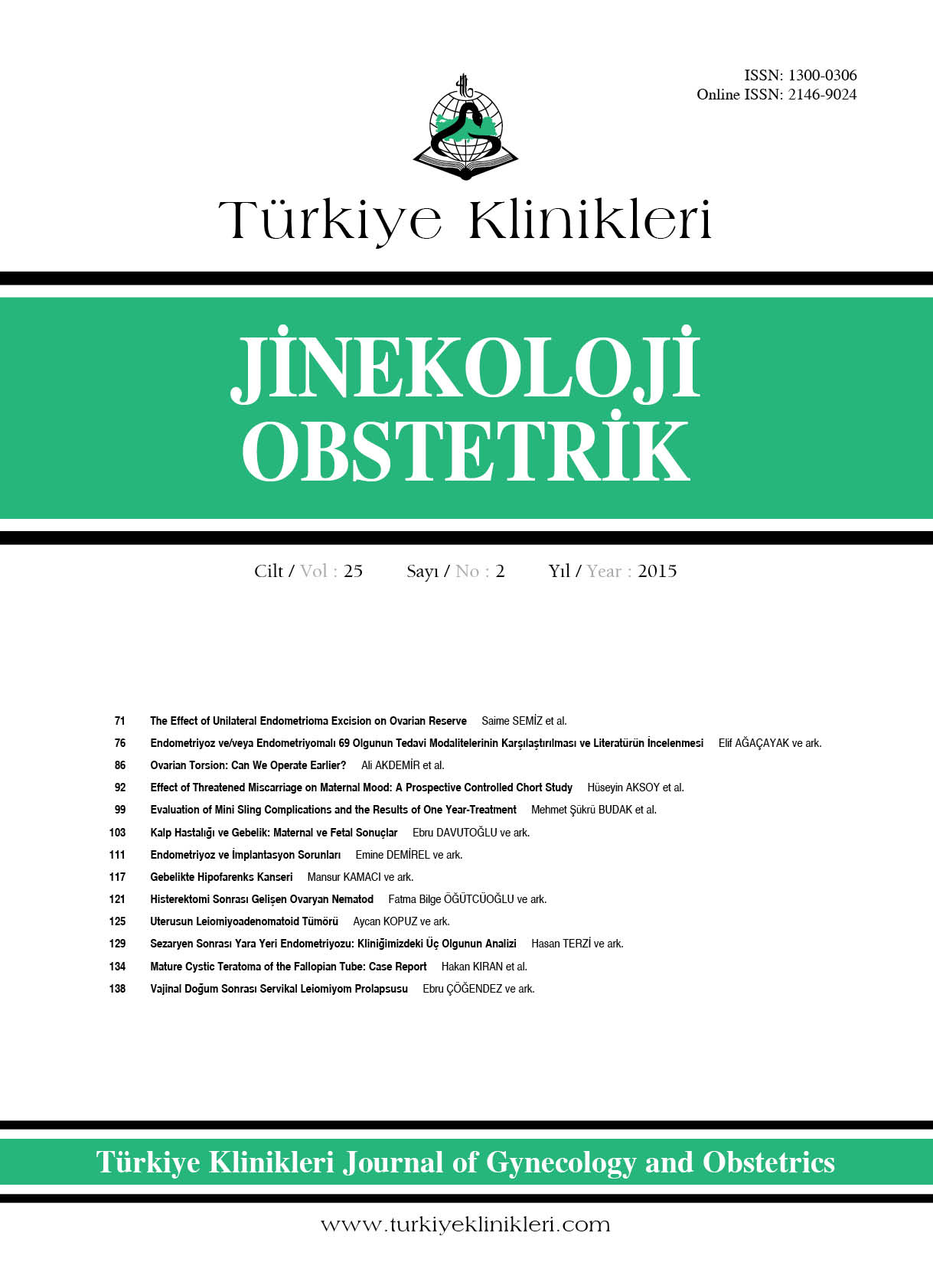Open Access
Peer Reviewed
REVIEW
3659 Viewed1821 Downloaded
Endometriosis and Implantation Failure: Review
Endometriyoz ve İmplantasyon Sorunları
Turkiye Klinikleri J Gynecol Obst. 2015;25(2):111-6
DOI: 10.5336/gynobstet.2013-38162
Article Language: TR
Article Language: TR
Copyright Ⓒ 2025 by Türkiye Klinikleri. This is an open access article under the CC BY-NC-ND license (http://creativecommons.org/licenses/by-nc-nd/4.0/)
ÖZET
Endometriyoz, östrojen bağımlı kronik inflamatuar bir hastalıktır. Endometriyoz doğurgan çağdaki kadınların yaklaşık %7'sinde, oral kontraseptiflere yanıt vermeyen kronik pelvik ağrısı olan grubun yaklaşık olarak %70'inde, subfertil gruptaki kadınların ise yaklaşık %50'sinde saptanır. Kesin tanısı için invaziv bir işlem olan laparoskopi işlemi gerektiğinden tüm popülasyon için kesin bir insidans rakamı vermek zordur. Endometriyoz ile subfertilite arasında güçlü bir birliktelik olduğu genel kabul gören bir kavramdır. İleri evre endometriyoz ve subfertilite ilişkisi net kurulabilirken, erken evre endometriyoz için sebep-sonuç ilişkisi bu kadar açık değildir. Endometriyoz ile subfertilite arasındaki sebep-sonuç ilişkisini açıklamak için yapılan ilginç oosit donasyon modellerinde sorumlu oosit gibi görünmesine karşın endometriyumun sorunsuz olmadığı bir gerçektir. Bununla birlikte donör oosit modelleri bu birlikteliği açıklamak için ideal bir model değildir. Çünkü donör oosit modelleri kohort açısından incelendiğinde ileri yaş ve prematür over yetmezliği olan gruptur ve bunlardan elde edilen sonuçlar tümüyle endometriyoz gruplarına uygulanamaz. Başarılı bir gebeliğin olmazsa olmazı olan implantasyon oldukça kompleks bir olaylar zinciridir. İmplantasyon başarısızlığının altta yatan biyomoleküler mekanizmaları çözüldükçe endometriyozda implantasyon sorunları daha anlaşılır hale gelmektedir. Son zamanlardaki çok sayıda genomik bazlı mikro dizilim çalışmalarına karşın ideal endometriyal reseptivite belirteci henüz mevcut değildir. Endometriyal reseptivite probleminin altta yatan fizyopatolojisinin çözülmesi hem tekrarlayan implantasyon başarısızlıklarında hem de açıklanamayan subfertilite yönetiminde yeni ufuklar açacaktır.
Endometriyoz, östrojen bağımlı kronik inflamatuar bir hastalıktır. Endometriyoz doğurgan çağdaki kadınların yaklaşık %7'sinde, oral kontraseptiflere yanıt vermeyen kronik pelvik ağrısı olan grubun yaklaşık olarak %70'inde, subfertil gruptaki kadınların ise yaklaşık %50'sinde saptanır. Kesin tanısı için invaziv bir işlem olan laparoskopi işlemi gerektiğinden tüm popülasyon için kesin bir insidans rakamı vermek zordur. Endometriyoz ile subfertilite arasında güçlü bir birliktelik olduğu genel kabul gören bir kavramdır. İleri evre endometriyoz ve subfertilite ilişkisi net kurulabilirken, erken evre endometriyoz için sebep-sonuç ilişkisi bu kadar açık değildir. Endometriyoz ile subfertilite arasındaki sebep-sonuç ilişkisini açıklamak için yapılan ilginç oosit donasyon modellerinde sorumlu oosit gibi görünmesine karşın endometriyumun sorunsuz olmadığı bir gerçektir. Bununla birlikte donör oosit modelleri bu birlikteliği açıklamak için ideal bir model değildir. Çünkü donör oosit modelleri kohort açısından incelendiğinde ileri yaş ve prematür over yetmezliği olan gruptur ve bunlardan elde edilen sonuçlar tümüyle endometriyoz gruplarına uygulanamaz. Başarılı bir gebeliğin olmazsa olmazı olan implantasyon oldukça kompleks bir olaylar zinciridir. İmplantasyon başarısızlığının altta yatan biyomoleküler mekanizmaları çözüldükçe endometriyozda implantasyon sorunları daha anlaşılır hale gelmektedir. Son zamanlardaki çok sayıda genomik bazlı mikro dizilim çalışmalarına karşın ideal endometriyal reseptivite belirteci henüz mevcut değildir. Endometriyal reseptivite probleminin altta yatan fizyopatolojisinin çözülmesi hem tekrarlayan implantasyon başarısızlıklarında hem de açıklanamayan subfertilite yönetiminde yeni ufuklar açacaktır.
ABSTRACT
Endometriosis is a chronic estrogen-dependent inflammatory disease. Endometriosis can be detected in approximately 7% of women in reproductive period, 70% in the group with chronic pelvic pain unresponsive to oral contraceptives and approximately 50% of subfertile women. It is difficult to give a precise incidence for the entire population as because an invasive laparoscopic procedure is required for the accurate diagnosis. A clear relationship has been established between advanced endometriosis and subfertility. However, it remains unclear whether early stage endometriosis is associated with subfertility. Although studies performed using oocyte donation models suggested that oocytes were responsible for this effect, it is clear that the endometrium is affected in patients with endometriosis. The implantation which is necessary for succesful pregnancy is a complex chain of events. When oocyte donor models were examined for cohort, it is seen that patients in the advanced age and with premature ovarian failure generates this group, and the results obtained from them entirely not applicable to the endometriosis group. A clear understanding of the biomolecular mechanisms that underlie implantation failure will facilitate the study of implantation problems in patients with endometriosis. Despite so many recent genomic microarray-based studies, ideal endometrial receptivity markers are not yet available. New horizons will be open for managing recurrent implantation failure and unexplained subfertility by solving the underlying pathophysiology of the problem of endometrial receptivity.
Endometriosis is a chronic estrogen-dependent inflammatory disease. Endometriosis can be detected in approximately 7% of women in reproductive period, 70% in the group with chronic pelvic pain unresponsive to oral contraceptives and approximately 50% of subfertile women. It is difficult to give a precise incidence for the entire population as because an invasive laparoscopic procedure is required for the accurate diagnosis. A clear relationship has been established between advanced endometriosis and subfertility. However, it remains unclear whether early stage endometriosis is associated with subfertility. Although studies performed using oocyte donation models suggested that oocytes were responsible for this effect, it is clear that the endometrium is affected in patients with endometriosis. The implantation which is necessary for succesful pregnancy is a complex chain of events. When oocyte donor models were examined for cohort, it is seen that patients in the advanced age and with premature ovarian failure generates this group, and the results obtained from them entirely not applicable to the endometriosis group. A clear understanding of the biomolecular mechanisms that underlie implantation failure will facilitate the study of implantation problems in patients with endometriosis. Despite so many recent genomic microarray-based studies, ideal endometrial receptivity markers are not yet available. New horizons will be open for managing recurrent implantation failure and unexplained subfertility by solving the underlying pathophysiology of the problem of endometrial receptivity.
MENU
POPULAR ARTICLES
MOST DOWNLOADED ARTICLES





This journal is licensed under a Creative Commons Attribution-NonCommercial-NoDerivatives 4.0 International License.










